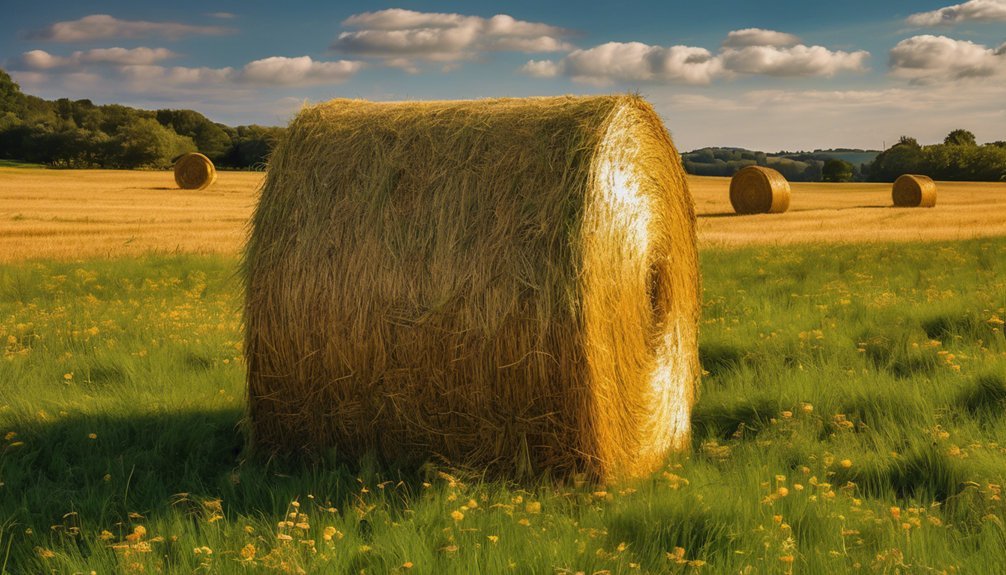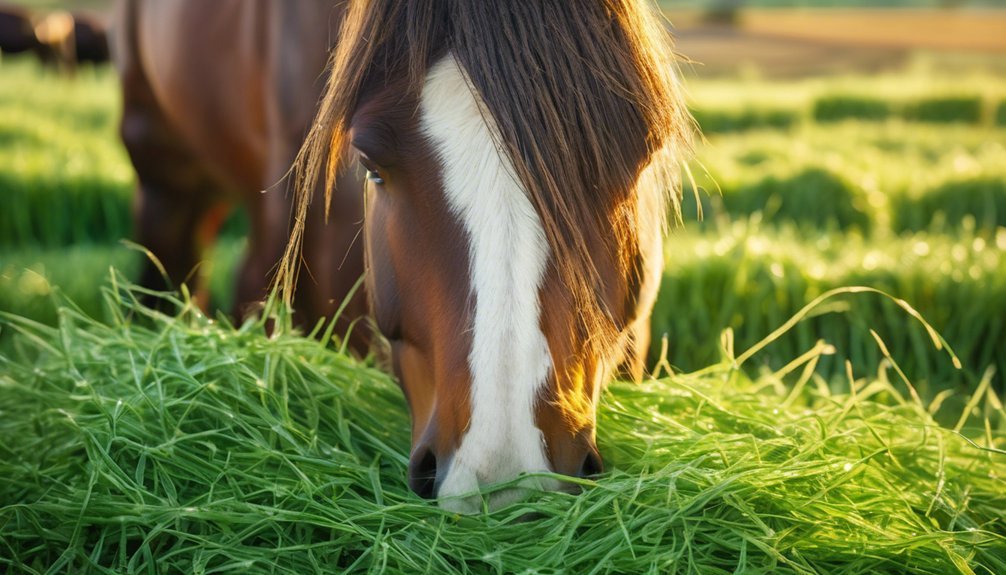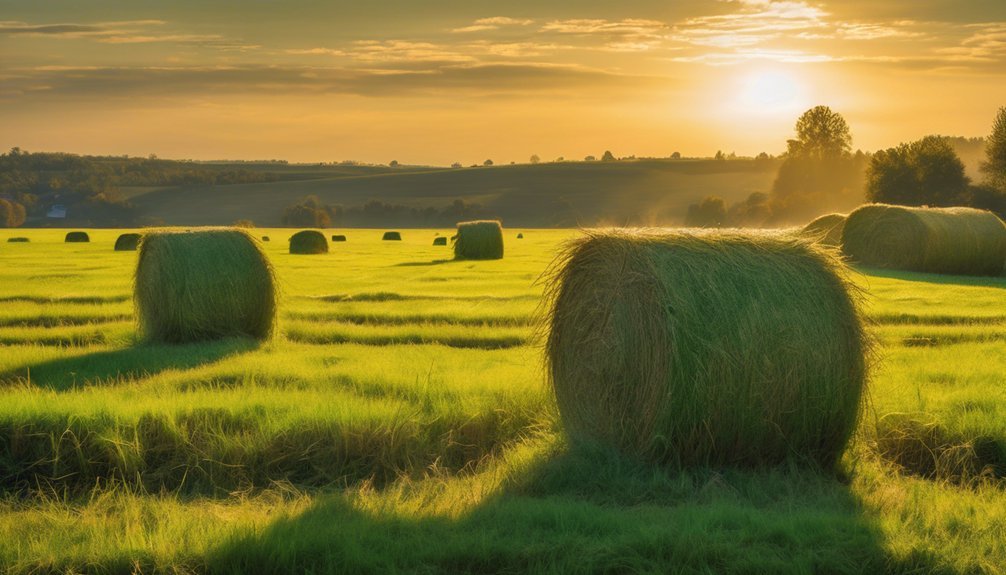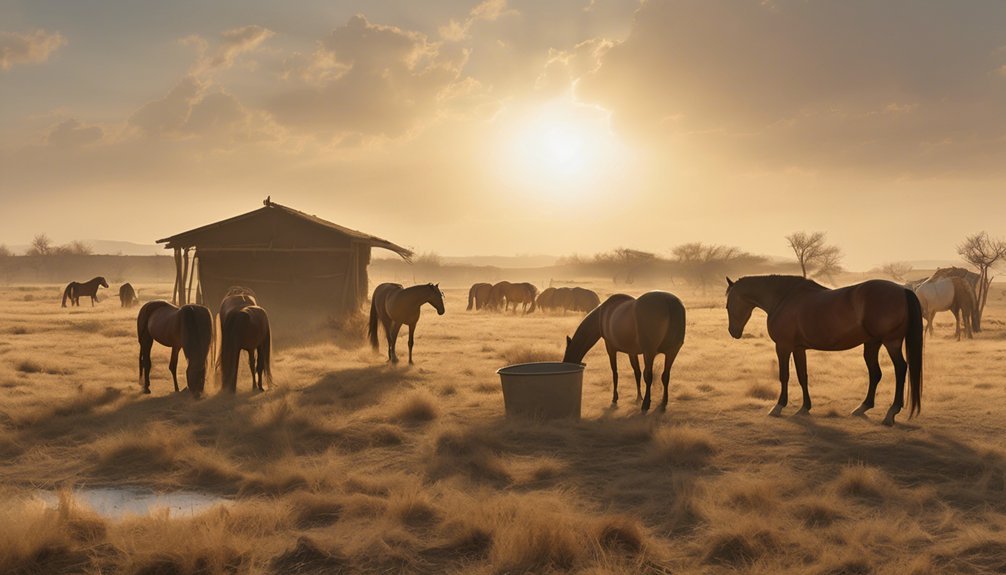
Imagine a field of vibrant, green hay swaying gently in the breeze, each blade packed with nutrients vital for your livestock's health. The quality of that hay goes beyond mere aesthetics; it influences everything from energy levels to reproductive success. Understanding this connection could change how you manage your operations. What you might not realize is how poor hay quality can lead to hidden costs that ultimately affect your bottom line.
Key Takeaways
- High-quality hay ensures optimal animal health by providing essential nutrients and promoting efficient digestion.
- Nutritional balance in hay directly impacts livestock performance, including energy levels and reproductive success.
- Proper hay handling and storage prevent moisture issues, maintaining quality and reducing health risks for animals.
- Investing in quality hay can lower veterinary costs and enhance overall productivity, improving profitability in the long run.
- Market demand for high-quality hay is rising, making it a strategic investment for future operational success.
Understanding Hay Types and Their Nutritional Value

When you choose hay for your livestock, understanding the different types and their nutritional value is crucial. The assortment of grass species available influences not just palatability but also nutrient content.
For instance, timothy and orchard grass offer high fiber and digestible energy, making them ideal for horses and small ruminants. Conversely, legume hays, such as alfalfa, pack more protein, which is beneficial for lactating animals.
By assessing the nutrient profiles of these hays, you ensure your livestock receives a balanced diet tailored to their needs. It's essential to consider factors like maturity at harvest and storage conditions, as these can further impact the quality and nutritional benefits of the hay you provide.
Prioritize wisely; your animals depend on it.
The Importance of Maturity at Harvest
Maturity at harvest plays a pivotal role in determining the nutritional quality of hay, impacting everything from digestibility to palatability.
When you consider harvest timing, you'll realize that cutting hay too early can lead to lower nutrient levels, while delaying harvest can result in excessive fiber and reduced digestibility.
Ideally, you want to harvest during the optimal window of plant maturity, when the balance of carbohydrates and proteins is at its peak.
This timing not only enhances the nutritional profile but also affects the taste and texture, making it more appealing to livestock.
How Hay Handling Practices Impact Quality

Although proper harvest timing is crucial, how you handle hay post-harvest can significantly influence its quality.
Effective hay storage practices are essential. You should ensure that bales are stored in a dry, well-ventilated area to prevent moisture accumulation, which can lead to mold and spoilage. Regularly check moisture levels; ideally, hay should have less than 15% moisture. If you notice any dampness, consider spreading the bales out to promote air circulation.
Proper handling during transport is equally important; avoid dropping bales or stacking them too tightly, as this can compress the hay and trap moisture.
The Relationship Between Hay Quality and Animal Health
High-quality hay is essential for maintaining optimal animal health, as it directly affects nutrition and overall well-being.
When you provide hay with high digestibility, your animals can break it down more efficiently, ensuring they absorb vital nutrients. This process is crucial; low-quality hay often leads to poor nutrient absorption, resulting in deficiencies that can compromise your animals' health.
You might notice changes in energy levels, coat condition, or even reproductive performance when hay quality falters.
By prioritizing high-quality hay, you're not just offering food; you're investing in your animals' vitality.
Ultimately, the better the hay, the healthier your animals will be, fostering a stronger bond between you and them through improved well-being and performance.
Economic Implications of Poor Hay Quality

When you underestimate the importance of hay quality, you may face significant economic repercussions that extend beyond immediate feed costs.
Poor-quality hay can lead to increased veterinary bills from health issues in your animals. Additionally, if your livestock aren't performing well, you might notice a dip in productivity, affecting your bottom line.
Analyzing current market trends reveals that demand for high-quality hay is rising, making it crucial to align your supply with these expectations.
A thorough cost analysis shows that investing in quality hay not only reduces long-term expenses but also enhances overall profitability.
In the end, prioritizing hay quality isn't just a matter of animal health; it's a strategic financial decision that can significantly influence your operation's success.
Tips for Selecting and Storing High-Quality Hay
How can you ensure that the hay you choose meets the highest standards? Start with hay selection tips: look for bright green color, soft texture, and a fresh smell. Avoid hay with mold or dust, as these can indicate poor quality.
When you find the right hay, consider the storage techniques. Keep it dry and off the ground to avoid moisture, which can lead to spoilage. Use a well-ventilated barn or shed, and store bales tightly packed to prevent air circulation that promotes mildew.
Regularly check your hay for signs of pests or deterioration. By following these practical tips, you'll not only preserve the quality of your hay but also ensure optimal health for your animals, creating a nurturing environment for them to thrive.
Frequently Asked Questions
How Can I Identify Mold in Hay Before Purchasing?
To identify mold in hay before purchasing, conduct a thorough hay inspection. Look for off-color spots, musty odors, or dust clouds. These signs indicate mold detection, ensuring you avoid low-quality hay that could harm your animals.
What Are the Signs of Hay Spoilage During Storage?
When you store hay, watch for spoilage indicators like discoloration, musty odors, or excessive dust. Poor storage conditions, such as high humidity or inadequate ventilation, can accelerate spoilage, compromising its quality and nutritional value.
Can Hay Quality Vary by Season or Climate?
Just as the seasons change like a Shakespearean play, hay quality does too. Seasonal variations and climate impacts can significantly affect nutrient content, making it crucial for you to monitor conditions throughout the year for optimal results.
How Does Hay Quality Affect the Feed Conversion Ratio?
Hay quality directly influences feed efficiency by determining its nutritional value. Higher quality hay provides essential nutrients, leading to better digestion and improved weight gain in animals, ultimately enhancing their overall performance and productivity.
What Are the Long-Term Effects of Using Low-Quality Hay?
Using low-quality hay can lead to a slow decline in your animals' health, causing nutritional deficiencies and digestive issues over time. You'll notice their energy waning, impacting their overall well-being and productivity significantly.
Conclusion
In the end, you might think that hay is just hay, but overlooking its quality could cost you more than you bargained for—both in animal health and your wallet. Investing in high-quality hay isn't just a luxury; it's a necessity for thriving livestock and a profitable operation. So, go ahead and choose that mediocre hay if you enjoy unexpected vet bills and the sight of your animals underperforming. After all, who needs healthy livestock and financial stability, right?





